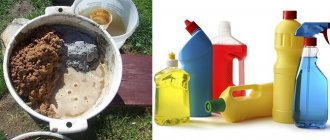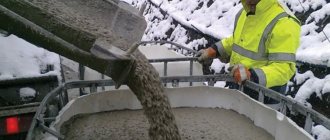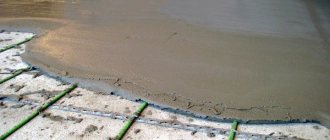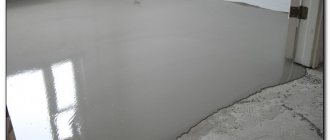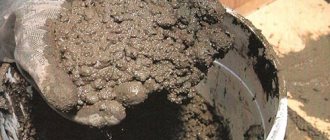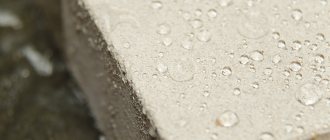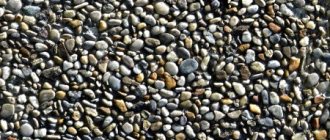Every year, in October - November, the same question is raised in many construction forums: “How much salt should be added to cement or concrete?”
Advertisement
This question arises among those builders who miscalculated their time and did not have time to complete all the cement-concrete work during the warm season. And then BAM!!! The first frosts have arrived.
One of my relatives faced this situation last year. In September it hit him in the head to build a foundation for a garage.
The foundation itself was made of natural stone (our area is full of it and it is the cheapest building material). And finally, I decided to pour concrete formwork on top of the stone foundation.
And just then the first frosts began. At night up to -5. Without despairing for a second, he added salt to the concrete mixture. I looked up the proportions somewhere on the Internet (2% salt of the total mass of concrete).
The result of this life hack, I saw the other day: the concrete pad was covered with a white coating, and the concrete itself was easily destroyed with the help of an ordinary nail. Well, how can you build a cinder block wall on such formwork???
If we compare the advantages and disadvantages of this method of preparing an anti-freezing solution, then there are so many disadvantages that it’s time to think: “Do I need it?” Why add salt to cement?
Salt in concrete or antifreeze additives for construction
At low temperatures, the hardening process of cement mixtures slows down significantly.
This is due to the fact that the water included in the building mass crystallizes under such conditions, interfering with the normal hydration process. For fresh concrete, such a situation is disastrous and has a very very bad effect on the strength of the structure being created. The process of crystallization of water from frost in a fresh solution leads to the fact that it becomes loose and is endowed with low frost-resistant properties. The physics of this process is simple and understandable even to schoolchildren. As water freezes, it expands, which breaks the bond between the cement and the aggregate.
LiveInternetLiveInternet
- Registration
- Entrance
-Music
- All (83)
—Categories
- knitting (2114)
- knitting needles (676)
- hats, mittens, socks (413)
- patterns (365)
- master classes (187)
- books, magazines on knitting (148)
- hook (125)
- scarves shawls stoles (83)
- jacquard (63)
- Tunisian knitting (23)
- knitting on a fork (3)
- health (1031)
- traditional medicine (403)
- help yourself (249)
- beauty is. (140)
- cooking (1015)
- baked goods (479)
- canning (95)
- dessert (70)
- teas drinks (69)
- meat (61)
- salads (52)
- vegetables (43)
- fish (35)
- kitchen tips (12)
- multicooker (12)
- steamer (3)
- garden (527)
- flowers (95)
- for home, garden (79)
- vegetables (55)
- pest and disease control (34)
- seedlings (32)
- trees and shrubs (26)
- organic farming, planning (8)
- berries (7)
- comfort in the home (4)
- fertilizers (1)
- reading room (386)
- legends and myths (4)
- poetry (335)
- handicrafts (295)
- sewing (128)
- patchwork (46)
- newspaper weaving (37)
- decorations (3)
- macrame (1)
- modeling (1)
- music (286)
- art (246)
- painting (229)
- humor (224)
- Zadornov (43)
- positive (2)
- useful tips (202)
- computer (147)
- cinema (105)
- feature films (50)
- actors (39)
- documentaries (12)
- For the diary (92)
- history (88)
- ancient civilizations (17)
- history of the Slavs (14)
- history of things (3)
- politics, power (84)
- economics (20)
- travel, tourism (67)
- Russian cities (22)
- Ural (16)
- Germany (1)
- interesting things (62)
- video (59)
- magic and esotericism (58)
- nature (57)
- roses (29)
- flowers (4)
- Astrology (56)
- new year (55)
- christmas (2)
- baptism (1)
- fauna (54)
- ZhZL (51)
- parable (27)
- aphorisms (10)
- holidays (25)
- numerology (25)
- unknown (24)
- forecasts (20)
- chatterbox (20)
- psychology (17)
- interior (15)
- from plastic bottles (15)
- astronomy (7)
- miscellaneous (6)
- architecture, monuments (4)
Antifreeze additives
Monolithic structures created in warm weather, after drying, are durable and high-quality structures.
Note! The greater strength of reinforced concrete products means that if it is necessary to create a hole in a given structure or shorten it, it is necessary to use methods such as cutting reinforced concrete with diamond wheels and diamond drilling of holes in concrete.
But in order to ensure the same level of strength for cement structures created in winter, it is necessary to use measures that allow water to be retained in the building mass in a liquid state.
Antifreeze additives, which are also called concrete setting and hardening accelerators, can help in this matter. They make it possible to reduce the freezing point of the liquid, thereby helping to normalize the hardening process of the cement monolith structure.
Ash instead of cement: heat-resistant mortar like stone. Exact proportions
Ash instead of cement: heat-resistant mortar like stone. Exact proportions
Research has been carried out and it has been proven that ash can be used in construction instead of cement. Ash bricks are made from it. Many people use ash as an additive to concrete. It contains calcium oxide, which has good cementing characteristics.
Reducing cement consumption is a huge plus in savings during construction. Ash serves as a filler that improves the structure formation of concrete. It is more environmentally friendly than Portland cement.
The strength of the mixture does not decrease, but on the contrary. If used for brickwork, then it will be impossible to disassemble the brick.
There are forgotten technologies. They are even better than today's.
How to replace cement and make it from ordinary ash
This fly ash cement is superior to ordinary Portland cement. It is heat resistant and lasts for years. It is quite possible to make it at home. And you don't need complex ingredients.
The solution will become like stone, dry quickly and adhere well to metal, stone, brick and other surfaces.
- Ash - 6 liters (wood ash is better, but coal is also suitable),
- Slaked lime (liquid, like milk) 3-5 liters,
- Regular salt – 1 kg.
Slaked lime must be diluted in the same way as is usually done for whitewashing walls. For example, 2.3 kg. for 10 liters of water.
We sift the ash and get rid of large debris (stones, etc.). It is also necessary to strain the lime through a sieve.
Pour the salt into the ash and mix thoroughly with a spatula. You can use any salt (coarse or fine).
Wear gloves. Pour lime into a basin with salt and ash. Add gradually until it becomes as thick as regular cement mortar. Mix the solution.
You can plaster with this solution or lay tiles on it. This mixture is good for covering cracks in stoves in the country or in a bathhouse, fireplace, tandoor. You need to apply the solution directly to a hot stove, as it is not afraid of high temperatures and the effect is much better.
An option for using the solution is to cover the gap between the pipe and the slate. To reduce shrinkage, add a little fine sand to the mixture.
Types of antifreeze additives
Means for this type on the modern market are presented in two main types:
- Compositions that interfere with the crystallization processes of liquids in building mixtures by lowering the freezing point of the building mass. They are also called retarders or mild cement set accelerators. These substances include two types of electrolytes:
- Strong - table or technical salt for concrete (sodium chloride), sodium nitride;
- not strong - ammonia solution, substances of limited origin (urea, polyhydric alcohols);
- Antifreeze compounds that help accelerate the hardening process and have high antifreeze properties. Such additives include potash, mixtures based on calcium chloride with sodium nitrite, with sodium chloride, etc.
Sodium and calcium chloride in concrete
Sodium chloride or ordinary construction salt has many advantages, due to which the popularity of this composition increases. Used in construction as an anti-frost component during sub-zero temperatures. Allows you to reduce the crystallization temperature of water.
Calcium chloride is used as an accelerator for the hardening of concrete mortar, as well as to increase its strength and resistance to variable weather conditions. By accelerating the setting process of concrete, the time for installation of cement-based structures is reduced. The use of an anti-frost additive in concrete allows construction to continue during the cold season.
Sodium chloride in the fight against frost
NaCl – sodium chloride (CN) or simple commercial salt. Concrete with technical salt is an excellent substance for construction work in winter at subzero temperatures.
Main characteristics of CN
Technical salt is added to the cement mortar to give it anti-frost properties.
This additive has the following properties and features:
Note! This component for concrete is the most inexpensive antifreeze additive.
- NaCl does not affect the rate of hardening of the solution; therefore, winter concrete with salt may have been mixed long before it was poured. Thus, mixing the building mass with this additive can be done, for example, at the factory long before its transportation to the construction site without loss of fundamental properties;
- Such an additive increases the mobility of solution particles, which facilitates the process of forming products of the desired shape from a given mass;
- It does not change the structure of the cement mass.
Advice. It is recommended to use calcium chloride together with sodium chloride.
The availability of this type of antifreeze additive and its low price is usually the reason that most builders resort to the use of completely different, more expensive means.
In addition to the many advantages of such an additive, it also has one significant drawback, which usually makes it unfeasible to use for concrete. The fact is that salt has a high level of corrosive activity.
And this shows that the use of metal reinforcement at the same time as a cement mixture with the addition of sodium chloride will lead to the process of rusting and peeling of this structure from the concrete.
Thus, the reinforced concrete structure loses its integrity, which significantly reduces the strength level of the entire product.
The process of adding salt to a solution
The instructions stipulating the proportions of salt in the cement mortar are based on the average daily temperature and expected strength:
- The average daily ambient temperature from 0 to -5 degrees suggests the addition of CN in the amount of 2% of the total mass of the mixture. The expected strength of the structure when dried in frost for 7 days will be 30%, 28 days - 80% and 90 days - 100%;
- The average daily ambient temperature from -6 to -15 degrees suggests the addition of CN in the amount of 4% of the total mass of the mixture. The expected strength of the structure when dried in frost for 7 days will be 15%, 28 days - 35% and 90 days - 50%.
Advice. The proportions of salt in concrete also require the addition of calcium chloride in the first case in the amount of 0.5% by weight of the solution, and in the second 2%.
Properties of antifreeze substances
When preparing an anti-frost solution for concrete with your own hands, it is necessary to take into account the fact that different types of plasticizers have different properties and characteristics. It is they who will subsequently influence the characteristics of the concrete itself and structures made from it.
So, for example, chloride salts added to the solution should not account for more than 7.5% of the cement mass. Potassium nitrite in such a mixture should occupy 10%, and potash - 15% of the specific gravity of cement. Moreover, if you use chloride salts as an anti-freeze additive, then by the time the water-salt solution freezes, the strength of the concrete cannot be less than 5.0 MPa. Such concrete must be cured under cover until the stripping strength level is reached.
The use of anti-frost plasticizers makes it possible to avoid heating a concrete structure only when the temperature at the construction site is not lower than the design temperature. If the maximum permissible concentration of chloride salts and sodium nitrite is introduced into the solution, the poured concrete can withstand a temperature of 15°C in the open air without heating.
In any case, if the temperature drops below the specified threshold, it will be necessary to take measures to insulate the formwork and cover the poured structure using the “thermos” method, as well as ensure their heating using steam or electricity.
Concrete solutions with a high level of salt plasticizers are good because they can tolerate negative temperatures when leaving the mixer. At the same time, to mix the mixture itself, you can take cold materials such as sand, crushed stone and gravel. At the same time, their temperature should not be lower than 15°C.
If you want to avoid early setting of the concrete mixture due to the presence of too many chloride plasticizers in it, it is prepared using a separate method. To do this, sand, cement and crushed stone are first mixed together with water, to which an anti-frost plasticizer with 70% mixing water has been added.
Only after this the remaining water is added to the solution, bringing the additive content to the required concentration. At the same time, at the time of completion of the process of preparing the concrete solution, it should be five degrees warmer than the freezing temperature.
When building a house or fence, every site owner wants the structure to have not only an attractive appearance, but also good technical characteristics. To improve these indicators, special substances - plasticizers - are added to the concrete solution. However, a more experienced builder, for economic purposes, often creates a plasticizer for concrete with his own hands. In this way, it is possible to significantly reduce the cost of the component and achieve better performance for the future building.
Advantages and disadvantages
In order to resolve this dispute, it is necessary to consider all the advantages and disadvantages of this method and draw a conclusion based on them. At the same time, the question of how much salt to add to concrete should be answered only if the research result is positive.
The consequences of using salt as an additive during winter installation affect not only the appearance, but also the strength
The need to use salt
It is generally accepted that if you add salt to concrete, it receives additional characteristics that allow it not to be covered with water in the cold, which means that work can be done in winter at sub-zero temperatures.
Also, some craftsmen claim that thanks to such delivery, the rate of hardening increases, since this substance draws out moisture.
It is worth remembering that concrete is also susceptible to corrosion, and a salty environment only accelerates this process.
- It is worth noting that no specialist can give an exact answer to the question of how much salt to add to concrete. The fact is that some builders believe that this depends on the total volume of the solution, while other craftsmen claim that the percentage is commensurate with the temperature outside.
- It is also necessary to say that the question of how much salt to add to concrete in winter is asked by people who have delayed repairs or have incorrectly allocated time for a particular process. If professionals plan to build in cold weather, they do not use additives, but additional heating systems and temperature-appropriate mixtures.
- It is very important to say that adding salt to concrete to give it special qualities is a kind of myth. The fact is that there is practically no benefit from this, since according to those who use it, the temperature should not be less than 7 degrees.
Advice! It is much easier to purchase ready-made concrete from a company that makes hot mixtures with a high pour point. However, you need to work with such a composition very quickly so that it does not set.
There are many other, more effective ways to heat the solution
Flaws
First of all, it should be noted that material with added salt can be sawed with regular wheels. You will no longer need to cut reinforced concrete with diamond wheels, since the hardened product will be less durable, which will also affect its service life.
It is worth noting that a salty environment has a negative effect on fittings. Therefore, if we add salt to concrete with metal inclusions, we must remember that it will almost immediately begin to cause corrosion and weaken the entire structure over time.
Also, such a technical solution will begin to produce visual effects over time. The salt will come to the surface in the form of a white sediment, which looks very unsightly.
Considering the seriousness of these shortcomings, professionals do not recommend using this method. At the same time, the question of how much salt should be added to concrete naturally remains unanswered.
Advice! Using warm formwork or artificial heating of concrete is much more practical, although it leads to additional costs.
Some antifreeze additives also significantly improve the strength of the finished product.
Calculation of masonry mortar
It was already mentioned above how much masonry mortar is needed for brickwork. More often they oppose the ratio taking into account per 1 m³ of wall being built. Typically, 20-30% of the finished mixture is used for this parameter.
In fact, today there is no need to count anything. There are tables freely available on the Internet where all the relationships are defined. For example, if you need to mix a solution of M50 brand, then for this you will need:
- cement grade M400 - 175 kg, based on the yield of 1 m³ of finished masonry mixture;
- M300 – 225 kg;
- M200 – 325 kg.
Consumption of solution depending on the type of work performed Source minkor.ru
Other Supplements
It is worth noting that the obsessive desire to do the work with your own hands and at sub-zero temperatures sometimes does not justify the costs at all. However, if the budget is small, then you can use special additives for concrete, which are sold on the building materials markets.
These materials allow you to work even at temperatures of minus 17, although this depends on the brand of the product chosen. At the same time, the strength of the solution does not decrease at all and diamond drilling of holes in concrete will again become relevant.
Antifreeze additives do not contain salt, but are environmentally friendly
Some craftsmen believe that such mixtures are not environmentally friendly. However, their instructions usually state the opposite, since such additives contain only natural ingredients.
Among the main advantages of such compositions is their cost-effectiveness. The fact is that their price and consumption are very low, especially compared to other heating options.
This mineral negatively affects concrete buildings and all its positive qualities do not justify the side effects
How long does it take for brickwork to dry outside: optimal temperature
Typically, construction work is carried out in the warm season, which is due to the properties of most materials. When deciding on the construction of certain elements of a building at sub-zero temperatures, they are guided by the characteristics of a particular solution and the level of complexity of the work. It is also necessary to take into account the technical capabilities and power of the additional devices used. The article describes at what temperature bricks can be laid.
How to choose the time of year and up to how many degrees you can lay bricks
Up to how many degrees can masonry be done? In the cold season, it is difficult to start building a building, since creating a building in freezing temperatures takes a significant amount of time and requires the use of additional equipment. At minus temperatures, almost any liquid freezes, which complicates the process of preparing cement mortar and other mixtures.
Due to a large number of difficulties, only a small part of developers decide to erect a building in the cold.
If there is an urgent need for construction in winter, if the workers have the appropriate level of skill, as well as the possibility of purchasing or renting additional equipment, this task is feasible.
You must follow the rules for preparing the solution and pay attention to certain nuances of the work so that the finished building looks presentable and is reliable.
In order to be guaranteed of the high quality of the brickwork, it is necessary to carry out construction work only in positive weather, and also to control the optimal level of air humidity.
Cement today is the most common material used in construction and renovation. Here are the characteristics and features of M400 cement.
Without tile adhesive today it is impossible to finish indoors. Here you will learn about the consumption of tile adhesive.
Arranging and decorating a kitchen apron will require a special approach from you, since the kitchen has high humidity. By clicking on the link, you will get acquainted with wall panels for the kitchen made of glass.
When the temperature drops, the hardening properties of the cement mortar worsen; at minus temperatures, it is impossible to prepare it without additional devices. If the temperature is too low, the water may freeze completely and turn into ice.
Conclusion
By watching the video in this article, you can get additional information about this concreting method. Also, taking as a basis the article proposed above, it should be concluded that salt is not the most successful additive for working in the cold season.
Salt in concrete and mortar: why and how much?
Of course, you can use special polymer-based additives that will prevent the water in the solution from freezing in the cold. But all this significantly increases the cost of the mixture. Previously, the construction magazine samastroyka.ru already talked about “folk” additives to concrete and mortar. The use of salt was also mentioned there, but only very superficially. This article will tell you why salt is added to cement mortar or concrete, as well as its specific proportions of use.
Cement-lime mixture
In the summer, when the outside temperatures are above zero, classic cement mortar is used to build walls or other types of brickwork. It is easy to prepare with your own hands from the following ingredients:
- Cement; Sand; Lime (may not be used at all in simpler mixtures).
First, a limestone dough is created.
It is made by mixing water with lime. Next, the resulting slurry is filtered using a fine sieve. Separately, but in parallel, a mixture consisting of sand and cement is mixed.
Next, the resulting limestone dough is poured into it, as well as the required volume of water and mixed until a homogeneous mass is created. It is with this mortar that bricks are held together in the summer. In cold times, things happen a little differently.
Why is salt added to concrete?
Adding salt to concrete and cement mortar makes it possible to carry out construction work at subzero ambient temperatures. It takes about a few days for the cement mortar to harden, but in cold weather, this period is significantly reduced. Because of this, the building mixture is destroyed from the inside, it becomes loose and fragile.
Salt added to the cement mortar prevents the water from freezing for some time in the cold, which has a positive effect on the quality of the mortar. However, the opinions of builders regarding the addition of salt to concrete and cement-based mortars are seriously divided.
Some of them believe that when salt is added to concrete, the corrosion of metal reinforcement elements increases sharply. Other builders, on the contrary, add salt to the solution and consider this additive to be the cheapest of all antifreeze additives. Salt allows the use of cement-based solutions at negative air temperatures.
Be that as it may, each additive to concrete and cement mortar should be used at your own peril and risk. In this case, you should definitely know its correct proportions in relation to the volume of the building mixture. Otherwise, you can only make things worse.
How much salt should be added to concrete and cement mortar?
The amount of salt in cement mortar or concrete depends entirely on the ambient temperature. Salt is added to concrete and cement mortars only if they have to be worked with at subzero temperatures, when it is necessary to prevent the rapid freezing of water and their destruction as a result.
So, for example, at air temperatures from 0 to - 5 degrees, the percentage of salt in the total mass of the building mixture should be approximately 2%. At temperatures from -5 to -15 degrees, salt is added to the cement mortar at least 4% of its total mass.
In addition, taking into account the high corrosion processes when adding salt to concrete, one main nuance can be highlighted: salt can be used as an anti-frost additive only for those concrete structures that do not have metal reinforcement elements. For example, when pouring concrete onto a blind area where reinforcement is not used. With this approach, salt, as an antifreeze additive, will be the cheapest option.
However, according to the same experts, it is better to completely abandon the use of concrete and cement mortars at subzero temperatures. It is advisable to plan concrete work so that it does not take place during the winter. In any case, both the strength and durability of building structures using concrete and cement mixtures built at this time will be much lower.
Question. Hello! In a private conversation with a neighbor who was building an extension to his house, I learned that he was adding kitchen salt to cement. True, the neighbor refused to answer the question of why he was doing this. Tell me why he does this and in general, does salt corrode cement and what effect does it have on the solution itself?
Answer. Good afternoon I want to reassure you right away - table (commercial) salt (chemical formula NaCl (sodium chloride) does not corrode cement. This is one of the most accessible and inexpensive antifreeze additives that ensures the continuity of concrete work in low temperatures.
The physical essence of adding table salt to cement (concrete) is to lower the freezing point of the mixer (water). As you know from high school physics, salt water has a lower freezing point. The freezing point of water depends on the salt concentration. The result of such an operation is as follows. Even at sub-zero temperatures, the curing agent is in a liquid state. This allows the cement to undergo the stages of hydration, setting and hardening to the required value without additional heating costs.
Advantages of NaCl as an antifreeze additive
- Lowest price among other analogues;
- Does not affect the setting speed of concrete or mortar. This allows you to prepare the material long before it is transported to the site and poured;
- Table salt increases the mobility of the solution, which in turn increases its workability.
NaCl addition proportions depending on expected ambient temperature
- The expected air temperature at the concrete work site is 0-5 degrees Celsius. The amount of salt added to concrete solutions is 2% of the total weight of the mixture. In this case, the strength of the concrete structure will be: 30% of the brand strength for 7 days, 80% of the brand strength for 28 days and 100% of the brand strength for 90 days;
- The expected air temperature at the concrete work site is minus 6 to minus 15 degrees Celsius. The amount of salt in the solution is 4% of the total weight of the mixture. The planned strength when concrete hardens in frost is: 15% of the brand strength for 7 days, 35% of the brand strength for 28 days and 50% of the brand strength for 90 days after pouring.
Despite the obvious advantages of adding salt to cement, there is a very, very significant drawback that limits the application options. Considering the high corrosion activity of steel reinforcement, table salt cannot be added to concrete intended for the construction of structures reinforced with a reinforcing belt made of steel elements. At the same time, table salt can be added to masonry mortars and mortars for pouring unreinforced structures, without any restrictions.
How to prepare solutions
So, having dealt with the classification, let’s move on to the question of how to prepare mortar for brickwork. Let's start with an important point - the proportions of ingredients.
Proportions of masonry mortar
Builders recommend that before mixing the mortar, pay attention to three important components: the type of soil on the construction site, the type of object being built, and the number of floors of the building. Taking this as a basis, we can talk about proportions:
- Cement mixture. Classic recipe: cement-sand – 1:3. This ratio can be changed up to 1:6, taking into account the conditions of use of the material. That is, what loads it will be subjected to. The less load, the greater the ratio. Next, the moisture content of the sand and the brand of cement itself are taken into account. The higher the brand, the greater the ratio of the two components.
- Lime. Here the proportions are from 1:2 to 1:5.
- Cement-lime. Here the cement-lime-sand ratio is from 1:1:6 to 1:3:15.
- Clay. Proportions of clay and sand: 1:1 or 1:2.
The question of how to prepare a mortar for bricklaying in proportions is closed, let's move on to the next section.
Proportions of masonry mortars in the table:
Source center-esm.ru
See also: Catalog of brick house projects
Brands of masonry mortars
Before moving on to labeling, I would like to dwell on an important point. This is a waste of material. For private developers it is very important, because the budget for building a house depends on it.
So, 0.25 m³ of mortar mixture is required for 1 m² of brickwork. Let us add for information that if the house is built from blocks, then the consumption will be only 0.05 m³. We also note that if hollow bricks are used to build walls, then the consumption will increase significantly due to the material getting inside the blocks. Therefore, builders recommend mixing a thicker solution. Somewhere of medium thickness. This mixture does not spread over the surface of the masonry.
Now let's move on to the markings:
- grades 0 and 2 are practically not used;
- but 4, 10, 25, 50 and 75 are the most common;
- There are so-called specialized masonry mortars with grades 100, 150 and 200, which are not used in private construction.
Brands of ready-made cement mortar in the table:
Source atlant-shop.com.ua
The marking includes not only numerical designations, but also letters. Usually the letter "M" is added to the number. For example, M10. This suggests that the masonry mortar can withstand a load of 10 kg/cm². In fact, it is a physical quantity called strength.
And another important characteristic is the mobility of the masonry mass. That is, to what extent the solution spreads over the brickwork and fills the pores. This parameter is determined by lowering a metal cone weighing 0.3 kg into the solution. Then the depth of immersion in centimeters is measured. This will be the plasticity of the solution.
This parameter, for example, for red brick should be 13 cm, for hollow brick 8 cm. It is recommended to increase the plasticity in summer, for which liquid plasticizers are usually used.
How to determine the mobility of masonry mortar Source ds04.infourok.ru
Features of masonry mortars
What mortar is needed for laying bricks:
- with high strength, because brick walls are always affected by external factors;
- with reliable adhesion, meaning high bonding with bricks;
- with sufficient manufacturability that allows you to apply the mixture in a thin layer;
- with good insulating qualities, for example, thermal insulation properties, sound insulation and moisture resistance.
See also: Catalog of companies that specialize in installation of ventilation, air conditioning and autonomous gasification equipment
Kneading technology
Having dealt with all the positions that answer the question of which mortar for laying bricks is best to choose, let’s move on directly to the main thing. And the first thing you need to pay attention to is kneading the mixture. This is done simply:
- The components of the bulk mass are prepared. Namely: cement, sand, water, plasticizers. If lime is required, then it is slaked.
- All main bulk components are mixed in the required proportions. That is, a dry mixture is formed. Then water and plasticizers are added to it in portions with stirring.
- Knead until the mixture becomes homogeneous.
Attention! The “life” of masonry mortar is short. After 1.5-2.0 hours it can no longer be used, because it simply begins to harden and, accordingly, lose its technical characteristics.
Water is added to the finished dry mixture Source sense-life.com
Technology for preparing solutions
With a simple masonry mortar everything is clear. We mixed cement and sand, then added water to the composition - and everything was ready.
With complex solutions everything is more complicated. Firstly, slaked lime is used for this. Essentially, this quicklime is filled with water and kept in this state for several hours. A so-called lime paste is formed. To prepare it, one portion of water is poured into three portions of the material.
It should be noted that the amount of lime added to the solution will depend on the brand of cement added. Therefore, we suggest you figure out how to make a mortar for bricklaying - the proportions of sand and cement with the addition of lime:
- If you need to make a mortar of M10 grade, then add it in different proportions: cement M150 - 1 part, lime - 1.2 parts, sand 9.5.
- Solution grade M25. It can be made by adding different grades of cement. For example, the ratio of the components cement-lime-sand, where M300 cement is used, will be: 1: 1.4: 10.5. If M200 grade cement is added, the ratio changes to 1:0.8:7. That is, the higher the grade of cement, the higher the proportions of other components.
- Brand of masonry mixture M50. There are more variations of recipes and preparations here. Let’s just list the ratios: with M400 cement – 1:0.9:8, with M300 – 1:0.6:6, with M200 – 1:0.3:4.
- Same for M75. With cement M500 – 1:0.8:7, with M400 – 1:0.5:5.5, with M300 – 1:0.3:4, with M200 – 1:0.1:2.5.
For load-bearing walls, M50 grade mortar is used Source 2.bp.blogspot.com
Is it possible to add salt to concrete: advantages and disadvantages of use
Quite often, when making various compositions or mixtures, professional craftsmen use components in the form of salt, which should give it additional qualities. At the same time, various disputes constantly arise about whether this should be done and in what proportions. Therefore, the question of why salt is added to concrete and how much is needed to achieve the desired result is of great concern to novice specialists.
Amateur photo of the consequences in the form of stains from rusting reinforcement and sedimentation on the surface when using salt in a concrete solution
By watching the video in this article, you can get additional information about this concreting method. Also, taking as a basis the article proposed above, it should be concluded that salt is not the most successful additive for working in the cold season.
Why add something to the solution?
Concrete really has extraordinary strength and a lot of advantages, but the solution also has disadvantages. For example, during frost it hardens for too long, as a result of which the water contained in the solution freezes and deteriorates the quality of the structure, making it brittle.
In the professional field, various plasticizers are used when preparing concrete. These are additives that improve the consumer qualities of concrete. Some substances can make the solution immune to frost or increase its strength many times over.
The disadvantage of plasticizers is their high cost, which is why they are only available to professionals. But similar properties of concrete can be achieved by adding other materials, which will be discussed below.
